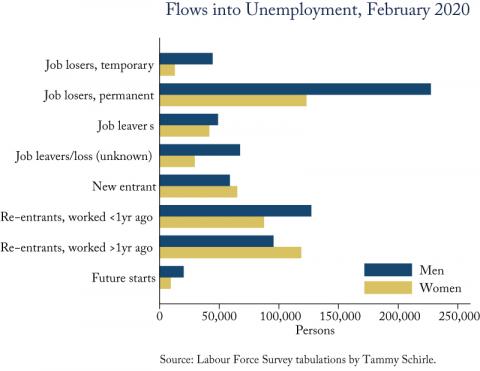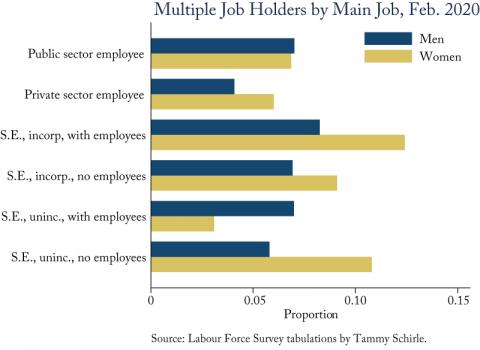From: Tammy Schirle
To: Employment Insurance Policymakers
Date: October 7, 2020
Re: Unemployment in the 21st Century
“This pandemic has shown that Canada needs an EI system for the 21st century, including for the self-employed and those in the gig economy.”
- Speech from the Throne, September 23, 2020
The fact that a large number of Canadians lack a safety net to catch them in a crisis has become much more salient to the average Canadian in 2020, prompting a conversation about how to better insure the earnings of workers in non-standard employment arrangements and better support a broader group in their search for work.
As long-term permanent policy that sets the stage for business and individual labour market decisions is developed, there’s a need to think clearly about who needs the support of an expanded safety net, and how best to build it. In this memo, I aim to describe some forms of unemployment, job loss, and earnings loss that are not well supported by the pre-pandemic Employment Insurance system.
First, who are the unemployed people who require support? Using information in the February 2020 Labour Force Survey, we see that only 30 percent of the people entering unemployment represent a permanent job loss, and five percent represent a temporary layoff. For the most part, people who have lost their jobs represent the unemployed that are the current target for regular EI support.
The job leavers (and those whose job loss reason is unknown) make up an additional 16 percent of the people entering unemployment. This will include some who have left self-employment jobs, but also those who have quit paid employment. Whether or not it was a good decision to leave their job, perhaps in search of a more productive match, they are not typically eligible for EI.
Nearly half of unemployed Canadians come into unemployment after having spent time away from the labour market. They may be new entrants to the market, or re-entering. Notably, 24 percent of women who entered unemployment in February were re-entrants who last worked more than a year before, rendering them EI ineligible. This would, for example, represent women who have returned to the labour market after taking time away to care for young children. This group has not been a target for EI in the past. Some support for job search activities among re-entrants therefore may be desirable, in light of the gendered nature of substantial career interruptions associated with caregiving.
Second, what insurance is sensible when job loss does not represent a complete loss of earnings? This is a concern for multiple job holders, who may have a combination of paid employment, self-employment, and gig work. In the February 2020 Labour Force Survey we see that five percent of men and seven percent of women held more than one job. Having multiple jobs is more common among the self-employed. This appears most common among women who are self-employed and incorporated with employees, as over 12 percent reported holding more than one job in February 2020. While some of these workers will be able to make use of EI’s Working While on Claim provisions, much of the work among multiple job holders remains uninsured.
Third, are there ways to better manage large and unexpected earnings losses that do not involve job loss? During the pandemic, eligibility for the Canada Emergency Response Benefit did not require a job separation to occur, and we saw clear evidence that many self-employed workers lost hours but remained employed during pandemic-related shutdowns. Similarly, the Canada Emergency Wage Subsidy supports wages paid to furloughed employees and those whose work hours were reduced. The work-sharing EI program assists with temporary reductions in hours, requiring agreements between employers, employees, and Service Canada. A large number of workers experienced substantial earnings losses, without job loss, during business shutdowns in 2020, and were often supported in the belief that maintaining good employer-employee matches during such temporary downturns is worthwhile.
But even if there was broad agreement that the earnings losses and unemployment described here should be insured by our EI system, there are practical problems that will impede any effort to cover earnings from self-employment. As has been pointed out elsewhere, the self-employed are a heterogeneous group, whose incomes tend to be much lower than workers in private sector paid employment. A key challenge for an EI system hoping to cover this group is to define insurable earnings, when reported self-employment earnings can be negative. A related challenge is to define the time periods in which earnings losses and benefits are evaluated for eligibility, as the timing of work, expenses, invoices, and payments, will rarely fit nicely into two-week benefit periods and there may be greater discretion over the timing of work for the self-employed relative to workers in standard paid employment.
An overriding concern here is that an expansion of EI to insure earnings in a more flexible way may result in moving further away from a program that insures workers against job loss, towards an income-smoothing program that provides a predictable share of some individuals’ income.
Overall, while an EI system that covers multiple job holders, gig workers, and the self-employed may be desirable in the 21st century, it is not clear how to build that system. EI programs that insure the various forms of unemployment and losses described above will reshape the labour market, distorting the decisions of businesses, employees and the self-employed in ways that may or may not be desirable.
Tammy Schirle is Professor of Economics at Wilfrid Laurier University, and is a C.D. Howe Institute Research Fellow.
To send a comment or leave feedback, email us at blog@cdhowe.org.
The views expressed here are those of the author. The C.D. Howe Institute does not take corporate positions on policy matters.







